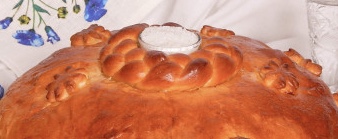



Have you ever made a homemade loaf? If not, then be sure to try it! There is something festive, solemn and triumphant in the process of making this bread. By the way, this is not surprising, because the loaf is the main wedding bread among the Slavs. It is customary to taste it first for the young at a wedding, and then share this skillfully decorated bread among all the participants in the celebration.
But here's another interesting thing: according to Russian custom, it is customary to meet dear guests with a loaf (this is called "Bread-Salt"), but also to see off the dead. So, for the day of mourning, a loaf is baked, which is then placed on the lid of the coffin, and distributed to the relatives of the deceased at the cemetery ...
This is such a many-sided bread, I suggest you bake. The crumb in the loaf turns out to be very airy, fluffy, and the bread itself is unusually tasty (after all, we have yeast dough). Try it and you will cook your first loaf!

Have you ever made a homemade loaf? If not, then be sure to try it! There is something festive, solemn and triumphant in the process of making this bread. By the way, this is not surprising, because the loaf is the main wedding bread among the Slavs. It is customary to taste it first for the young at a wedding, and then share this skillfully decorated bread among all the participants in the celebration.
But here's another interesting thing: according to Russian custom, it is customary to meet dear guests with a loaf (this is called "Bread-Salt"), but also to see off the dead. So, for the day of mourning, a loaf is baked, which is then placed on the lid of the coffin, and distributed to the relatives of the deceased at the cemetery ...
This is such a many-sided bread, I suggest you bake. The crumb in the loaf turns out to be very airy, fluffy, and the bread itself is unusually tasty (after all, we have yeast dough). Try it and you will cook your first loaf!
Sign up to receive email updates on new recipes.